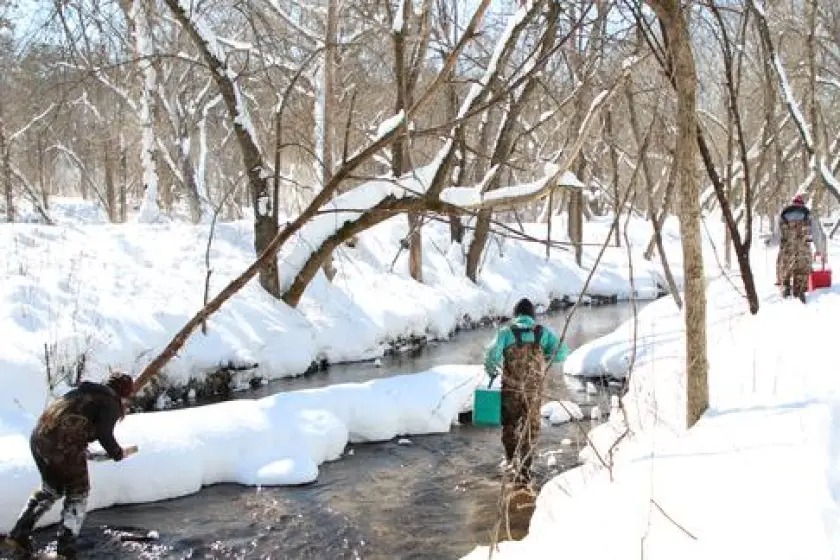University of Minnesota Extension at UMD is helping produce a free online event to raise awareness about the winter life of the little creatures in trout streams that make up the backbone of the food chain for fish.
“Bugs Below Zero: Engaging Citizens in Winter Research” is set for 6:45 p.m. Thursday, Jan. 11.
A student inspects insects collected during winter months from a Minnesota trout stream as part of the Bugs Below Zero project. (Sarah Karnas / Bell Museum)
Biologist Amy Schrank, an expert on trout streams stationed at Sea Grant’s University of Minnesota Duluth headquarters, will be joined by Rebecca Swenson, associate professor at the university’s College of Food, Agricultural and Natural Resource Sciences, and by Alyssa Anderson, associate professor of biology at Southwest Minnesota State University.
Bugs Below Zero is a Minnesota Sea Grant project designed to draw attention to the importance of winter stream food webs and how citizens can be involved in community science to contribute to stream conservation and winter ecology research.
Some insects, including stoneflies, mayflies, caddisflies and non-biting midges, are active in the winter months. These bugs can survive below-zero temperatures and can often be found on snowbanks. They are also a vitally important food for trout. Researchers are examining how seasonal changes may alter these insects’ life cycles and trout populations.
The biggest concern? If the climate continues to warm, as Minnesota experienced in December, insects that emerge in winter and depend on cold will disappear, and so will the trout that depend on them.
The University of Minnesota Bugs Below Zero Team has been discovering the life-cycle dynamics of non-biting midges and their importance to trout for more than a decade. Now, the research group is looking for volunteers to help with monitoring efforts and to expand the scope of this research program.
“The first goal of the program is to get people excited and educated about bugs in winter, and bugs in streams,” said Swenson. “But then we want people to get involved and go out and help collect data.”
When the snow finally flies, the University’s Bugs Below Zero team wants citizen scientists — K-12 and community college science teachers and their students, angling groups and anyone interested — to join them in a community science project that expands the understanding of winter active aquatic insects.
“Trout fishermen have really been active in this so far,” Swenson told the News Tribune. “But it could be anyone who likes to be outside in wi
Yes, mayflies and other insects are alive and active in winter and play an important role in the ecology of a trout stream. You can help uncover more about that role by participating in Bugs Below Zero. Some insects, including stoneflies, mayflies, caddisflies and non-biting midges, are active in the winter months. These bugs can survive below-zero temperatures and can often be found on snowbanks. They are also a vitally important food for trout. Researchers are examining how seasonal changes may alter these insects’ life cycles and trout populations. (Courtesy of the University of Minnesota)
nter: hikers or cross-country skiers or whatever. You don’t have to be a fisherman to get into this.”
Participants identify and submit information and photographs of aquatic insects on the snow, often near stream banks and then upload their findings on an app. Your help can grow the understanding of how the unique Minnesota climate reveals valuable insights about interactions between weather, water, insects and food webs for researchers across the globe.
Schrank, the Extension program leader, is a fish biologist with more than 15 years of experience teaching and conducting research in Great Lakes aquatic ecosystems. Her background includes work on trout movement, stream and lake fish ecology, the effects of dam removal on fishes and how invasive plants impact fish communities in Great Lakes coastal wetlands.
For more information on Bugs Below Zero, go to bugsbelowzero.com.
How to register
Go to the University of Minnesota Extension Minnesota Master Naturalist Meetings and Events webpage at westmetromasternaturalists.weebly.com/meetings.html to sign up. A free, in-person version of the event will be held Feb. 3 at 5 p.m. in the Joseph J. Casby Observatory, 1553 Stagecoach Trail S. in Afton.
Related Articles
First meteor shower of 2024 could be the strongest; Quadrantids set to peak Jan. 3-4
Ice assessment team formed to decide when Upper Red Lake will reopen for ice fishing
As snow fails to fall on North Shore, organizers cancel John Beargrease Sled Dog Marathon
Another day, another northern Minnesota ice rescue: This time, 50 stranded anglers brought to shore
Upper Red Lake vehicle restrictions issued after recent incidents on poor ice


Leave a Reply